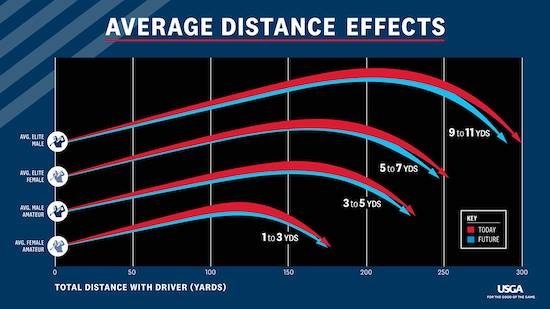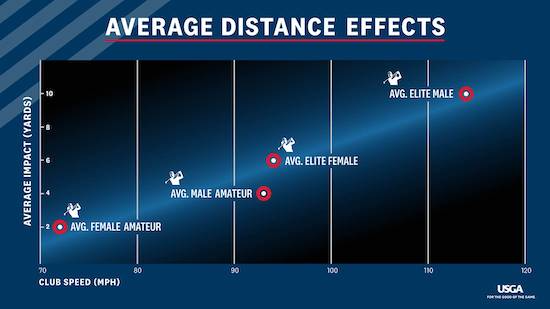It's official, the USGA and R&A will roll back the ball starting in 2028
Following a long, arduous process, the USGA and R&A have put their stake in the ground and decided that the golf ball requires a universal rollback for professionals and amateurs alike. The rollback will start for pros in 2028 and amateurs in 2030.
In March, the USGA and R&A proposed that a Model Local Rule (MLR) be implemented to allow courses and tournaments the option of playing a rolled-back ball in certain scenarios. This rollback was believed to pertain to only professionals and elite amateurs. It would set the stage for bifurcation in golf, which would alter, for some, one of the most critical aspects of the game - that we all play the same equipment.
That proposal was met with severe pushback, particularly from professionals and golf ball manufacturers who would have to return to square one in order to develop a ball that only a small percentage of golfers would need. However, as the USGA and R&A have done for the last 12 years as they have digested and processed vast amounts of information pertaining to how far the ball travels, they allowed a comment period so people could voice their opinions.
Fast forward to Friday, December 1, when Golf Digest reported that the USGA and R&A had decided that the time was ripe to roll back the golf ball for all golfers. The move surprised many after the initial MLR proposal in March. A sweeping change still struck a chord with many who fear that the average player will suffer greatly from the loss of yardage and potentially leave the game for other more enjoyable pursuits.
It's hard to deny that distance is becoming more of an issue in golf. The USGA has released a distance report every year since 2016, documenting the distance players of all levels are hitting the ball. Here is the 2022 report.
It's likely that this announcement will echo through history as an important moment for the game of golf. It might be the beginning of other technological tweaks to the game to keep golf courses sustainable, as they won't need to continue building bunkers and tees to challenge players. It also might signal a decline in growth of the game if participants deem the rule too harsh.
Here is the full USGA press release from December 6, 2023.
The R&A and USGA will update the testing conditions used for golf ball conformance under the Overall Distance Standard (ODS), which will take effect in January 2028. The decision aims to reduce the impact increased hitting distances have on golf’s long-term sustainability while minimizing the impact on the recreational game.
The revised ball testing conditions will be as follows: 125-mph clubhead speed (equivalent to 183 mph ball speed); spin rate of 2200 rpm and launch angle of 11 degrees. The current conditions, which were established 20 years ago, are set at 120 mph (equivalent to 176 mph ball speed), 2520 rpm with a 10-degree launch angle.
The revised conditions are based on analysis of data from the worldwide tours and the game over several years and are intended to ensure that the ODS (whose limit will remain unchanged at 317 yards with a 3-yard tolerance) continues to represent the ability of the game’s longest hitters. An analysis of ball speeds among golf’s longest hitters in 2023 shows that the fastest 10 players had an average ball speed of 186 mph, while the average ball speed of the fastest 25 was 183.4 mph (the very fastest averaged 190 mph).
The longest hitters are expected to see a reduction of as much as 13-15 yards in drive distance. Average professional tour and elite male players are expected to see a reduction of 9-11 yards, with a 5-7-yard reduction for an average LPGA or Ladies European Tour (LET) player.
The change in testing speed is expected to have a minimal distance impact, 5 yards or less, for most recreational golfers. Research shows an average swing speed of 93 mph for male golfers and 72 mph for female players.

Existing balls approved for conformance in 2027 may continue to be used by recreational golfers until January 2030 to give golfers, manufacturers and retailers additional time to adjust. These decisions are in line with the commitments made by the governing bodies at the project’s inception.
A significant portion of golf ball models that are currently in the market – and more than 30 percent of all golf ball models submitted for conformance across the game – are expected to remain conforming after these changes are applied.
“Governance is hard. And while thousands will claim that we did too much, there will be just as many who said we didn’t do enough to protect the game long-term,” said Mike Whan, CEO of the USGA. “But from the very beginning, we’ve been driven to do what is right for the game, without bias. As we’ve said, doing nothing is not an option – and we would be failing in our responsibility to protect the game’s future if we didn’t take appropriate action now.”
Martin Slumbers, CEO of The R&A, said, “We are convinced that this decision is one of the key ways of achieving a sustainable future for golf, protecting the integrity of the game and meeting our environmental responsibilities. The measure we are taking has been carefully considered and calibrated while maintaining the ‘one game’ ethos deemed to be so important to the golf industry. Importantly, it also keeps the impact on recreational golfers to an absolute minimum. We are acting now because we want to ensure that future generations can enjoy the unique challenge of golf as much as we do.”
The Notice of Decision follows the most thorough and comprehensive examination of the issue in the game’s history through the Distance Insights project, which was launched in 2018 and gathered data, shared research and solicited feedback from golf course owners, players, and stakeholders across the game. Data provided by the seven major worldwide tours has also been analyzed by the governing bodies, who have published Annual Driving Distance Reports every year since 2015.
The reports followed the governing bodies’ joint Conclusions from the Distance Insights Project: Implication of Hitting Distance in Golf, which shared the reasons why addressing the continuing trend of hitting distance increases and subsequent course lengthening is critical to the game’s long-term sustainability.
All golf ball and club manufacturers were advised of the decision on Tuesday, Dec. 5, and were given full technical details and an implementation timeline. The notice of decision takes into account the extensive research and feedback received from manufacturers and other industry stakeholders throughout the six-year process and following multiple Areas of Interest and proposals starting in 2021 as part of the Equipment Rulemaking process.
Click on each link for official documents and a letter sent to the industry here: Letter | Technical Documents.

In addition to the new ball-testing conditions, the governing bodies will:
- Expand the testing approach to better detect ‘Driver Creep,’ which can result in drivers exceeding the limits set out in the Equipment Rules. This is a change in the testing methodology for submitted drivers, to identify and proactively address driver models that are within current tolerance levels and have Characteristic Time (CT) values that are more likely to exceed the limit through regular use.
- Continue to monitor drivers and explore possible additional options related to distance. Specifically, we will research the forgiveness of drivers and how they perform with off-center hits. This is an ongoing review and we will seek input from and continue to work with the industry, including manufacturers, to identify driver design features that can be regulated as a means to reward center impact position hits versus mis-hits.
The Overall Distance Standard was first introduced in 1976 and has been updated on three previous occasions (1980, 2002 and 2004). This is the first time that test speeds have been updated since 2004, when the current standard was set based on the longest hitters at that time.
Details on the study and complete technical data on the Distance Insights project can be found at www.usga.org/distanceinsights.
Most Popular Articles

2025 PGA TOUR Q-School Guide: Sites, Scores, and Who Advanced
Dec 5, 2025Second Stage is complete and Final Stage awaits at Sawgrass — follow every Q-School leaderboard and the players still chasing
2025 LPGA TOUR Q-Series: Final Qualifying Stage FINAL SCORING
Dec 8, 2025Helen Briem earns medalist honors, 31 players headed to the LPGA next year
2025 PGA TOUR Q-School Final Stage: Ewart Leads Five New TOUR Card Winners
Dec 14, 2025A.J. Ewart topped Final Stage at TPC Sawgrass, leading five players who secured PGA TOUR membership for 2026.
Australian Open at Royal Melbourne: Preview, amateur bios, and how to watch
Nov 30, 2025Rory McIlroy headlines one of the championship's top fields in years - at least four amateurs will have their chance at gloryInside Gil Hanse’s Restoration of Baltusrol’s Upper Course: A Return to Tillinghast’s
Dec 11, 2025Renowned architect Gil Hanse reveals how he brought Baltusrol’s Upper Course back to life by honoring A.W. Tillinghast’s originalLoading latest news...
